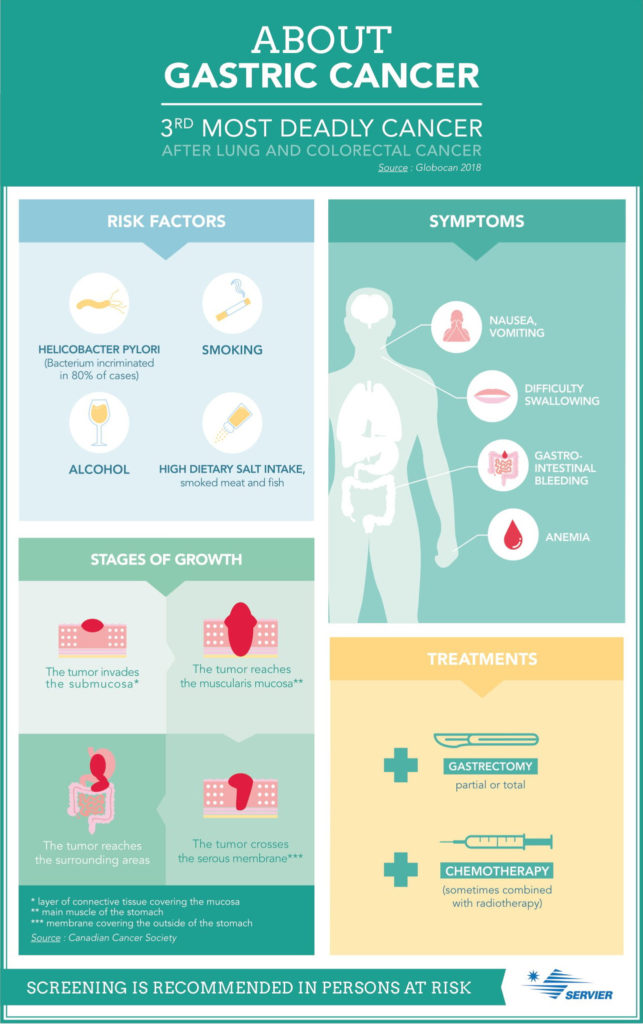Gastric cancer is associated with several environmental and behavioral risk factors. Due to its general, nonspecific symptoms, this type of cancer is often detected too late, resulting in a poor prognosis.

Also known as stomach cancer, gastric cancer is more prevalent in developing countries than industrialized ones. The most affected countries are in Asia (including China) and South America (mainly Chile, Peru, and Colombia), as well as Eastern Europe. An exception for industrialized countries is Japan1, which has a particularly high incidence of the disease. Sub-Saharan Africa, on the other hand, is relatively unaffected, with a lower incidence than Europe.
This distribution can be explained by the nature of the risk factors. The main risk factor is the presence of Helicobacter pylori (H. pylori) bacteria in the stomach; this is responsible for 80% of gastric cancers.2 This strain of bacteria is generally contracted in childhood – usually transmitted orally from parent to child due to proximity – and is the cause of chronic gastritis, an inflammation of the stomach lining that develops into cancer in 1% of people infected.3 Thanks to better hygiene practices, improved food preservation methods, and access to drinking water and antibiotics, the prevalence of H. pylori infection is diminishing.
Other identified risk factors include smoking, alcohol, inadequate fruit and vegetable intake, and a diet high in salt or including too much smoked meat and fish (high consumption of smoked products is believed to be the reason for the elevated incidence in Japan). Family history or genetic predisposition may also be associated with the disease. Like other cancers, the chances of survival increase with early diagnosis.
+ 1.03 M
More than 1.03 million new cases occurred worldwide in 2018, making it the fifth most common cancer.
≈783,000
Nearly 783,000 people died from gastric cancer in 2018, making it the third deadliest cancer in the world.
1.75 M
By 2040, gastric cancer could affect 1.75 million people, which is 69% more than in 2018.
The stomach: the main organ in the digestive process
The stomach performs two functions in the body. The first is chemical: It produces a combination of acids and enzymes, gastric juices, which are essentially a mixture of hydrochloric acid and digestive enzymes, in particular pepsin, which breaks down proteins.
The second function is mechanical: It aids digestion. When the stomach muscles contract, they knead the stomach contents, transforming it into a semi-fluid mass (chyme), which is then transported to the intestine. Most stomach cancers (over 90%) are adenocarcinomas4 that occur in the stomach lining, the innermost layer where the acid- and enzyme-producing glands are located. Cancer can affect the entire stomach. When the cancer occurs in the upper two thirds of the stomach (near the esophagus), the tumors are referred to as proximal. When the cancer occurs in the lower third of the stomach, near the intestine, the tumors are called distal.

Early cancer detection
Gastrectomy, a major surgical procedure
Surgery can be performed when the cancer is diagnosed in the early stages (only the mucous lining is affected), when localized (restricted to the stomach), or when locally advanced (spread to adjacent organs, nearby lymph nodes). Sometimes, when the tumor has metastasized to other organs (liver, lungs, ovaries), surgery is proposed in order to reduce the size of the tumor.
Depending on the disease stage, the surgeon will remove all or part of the stomach (total or partial gastrectomy). The operation also involves restoring the continuity of the digestive tract when possible. Otherwise, it is necessary to perform a gastrostomy, which involves connecting an artificial feeding mechanism directly to the stomach from the outside, for nutritional support.
Side effects of gastrectomy can occur in the short term (hemorrhage, infection, pain, loss of appetite and weight, diarrhea, et.), as well as the long term. Removal of the stomach, especially complete removal, can result in fatigue, psychological disturbances, and anxiety. Deficits in iron and vitamins B9 (folate) and B12 can occur. In the case of vitamin deficiency, monthly injections are required to prevent anemia, and must be continued for life.
Chemotherapy to maximize chances of survival
Chemotherapy, which is sometimes combined with radiotherapy, can be administered prior to the operation (preoperatively) in order to reduce the size of the tumor so that it can be more easily removed. Preoperative chemotherapy treatment lasts between 2 and 3 months. As for postoperative chemotherapy, with a duration of 2 to 4 months, the purpose is to reduce the risk of recurrence for high-risk patients by eliminating residual cancer cells. In the presence of metastases (secondary tumors), so-called palliative chemotherapy slows the progression of the disease and relieves the symptoms linked to the tumor; this improves quality of life while also extending length of life.
And Servier?
Servier has made oncology one of its foremost priorities, investing more than 50% of its R&D budget in the field. The Group hopes this will help it become a renowned innovator in developing cancer treatments.
The Group’s strategy in oncology is:
In collaboration with the coalition Digestive Patient Europe, the Group has published the leaflets “My Food“, “MyMood” and “MyDialogue“, to improve the daily lives of patients who live with digestive cancer and their loved ones.
KEY POINTS
[1]Source Globocan 2018, International Agency for Cancer Research – WHO. Available at: https://gco.iarc.fr/today/data/factsheets/cancers/7-Stomach-fact-sheet.pdf
[2]https://www.e-cancer.fr/Patients-et-proches/Les-cancers/Cancer-de-l-estomac/Facteurs-de-risques
[3]Léon Bérard Centre ; Available at : https://www.cancer-environnement.fr/417-Cancer-de-lestomac.ce.aspx
[4]ALD No. 30 – Doctor’s guide to stomach cancer, HAS, September 2011.Available at: https://www.has-sante.fr/jcms/c_1105135/fr/ald-n-30-guide-medecin-sur-le-cancer-de-l-estomac

